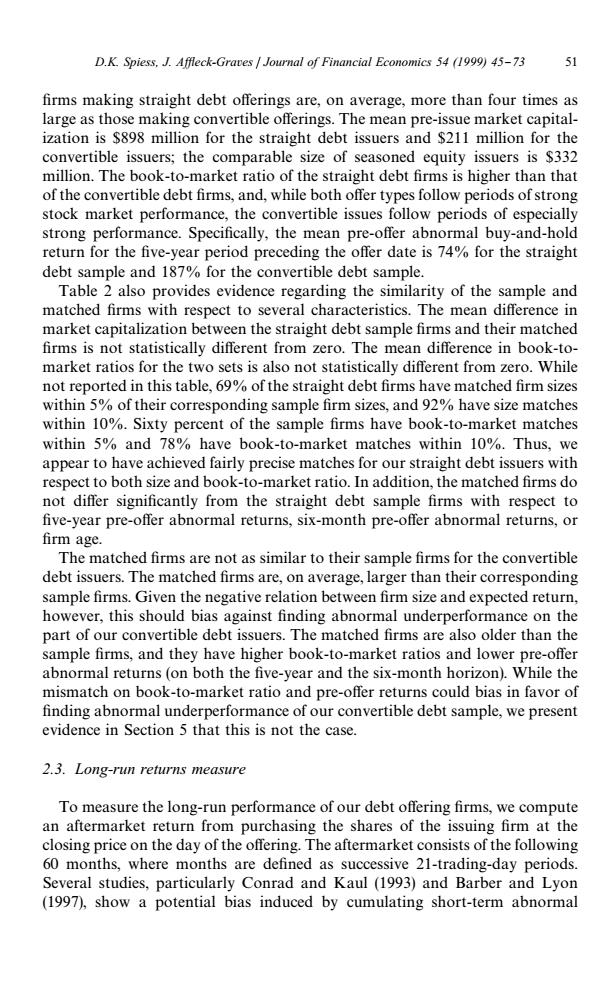正在加载图片...

D.K.Spiess,J.Affleck-Graves Journal of Financial Economics 54 (1999)45-73 51 firms making straight debt offerings are,on average,more than four times as large as those making convertible offerings.The mean pre-issue market capital- ization is $898 million for the straight debt issuers and $211 million for the convertible issuers;the comparable size of seasoned equity issuers is $332 million.The book-to-market ratio of the straight debt firms is higher than that of the convertible debt firms,and,while both offer types follow periods of strong stock market performance,the convertible issues follow periods of especially strong performance.Specifically,the mean pre-offer abnormal buy-and-hold return for the five-year period preceding the offer date is 74%for the straight debt sample and 187%for the convertible debt sample. Table 2 also provides evidence regarding the similarity of the sample and matched firms with respect to several characteristics.The mean difference in market capitalization between the straight debt sample firms and their matched firms is not statistically different from zero.The mean difference in book-to- market ratios for the two sets is also not statistically different from zero.While not reported in this table,69%of the straight debt firms have matched firm sizes within 5%of their corresponding sample firm sizes,and 92%have size matches within 10%.Sixty percent of the sample firms have book-to-market matches within 5%and 78%have book-to-market matches within 10%.Thus,we appear to have achieved fairly precise matches for our straight debt issuers with respect to both size and book-to-market ratio.In addition,the matched firms do not differ significantly from the straight debt sample firms with respect to five-year pre-offer abnormal returns,six-month pre-offer abnormal returns,or firm age. The matched firms are not as similar to their sample firms for the convertible debt issuers.The matched firms are,on average,larger than their corresponding sample firms.Given the negative relation between firm size and expected return, however,this should bias against finding abnormal underperformance on the part of our convertible debt issuers.The matched firms are also older than the sample firms,and they have higher book-to-market ratios and lower pre-offer abnormal returns (on both the five-year and the six-month horizon).While the mismatch on book-to-market ratio and pre-offer returns could bias in favor of finding abnormal underperformance of our convertible debt sample,we present evidence in Section 5 that this is not the case. 2.3.Long-run returns measure To measure the long-run performance of our debt offering firms,we compute an aftermarket return from purchasing the shares of the issuing firm at the closing price on the day of the offering.The aftermarket consists of the following 60 months,where months are defined as successive 21-trading-day periods. Several studies,particularly Conrad and Kaul (1993)and Barber and Lyon (1997),show a potential bias induced by cumulating short-term abnormal"rms making straight debt o!erings are, on average, more than four times as large as those making convertible o!erings. The mean pre-issue market capitalization is $898 million for the straight debt issuers and $211 million for the convertible issuers; the comparable size of seasoned equity issuers is $332 million. The book-to-market ratio of the straight debt "rms is higher than that of the convertible debt "rms, and, while both o!er types follow periods of strong stock market performance, the convertible issues follow periods of especially strong performance. Speci"cally, the mean pre-o!er abnormal buy-and-hold return for the "ve-year period preceding the o!er date is 74% for the straight debt sample and 187% for the convertible debt sample. Table 2 also provides evidence regarding the similarity of the sample and matched "rms with respect to several characteristics. The mean di!erence in market capitalization between the straight debt sample "rms and their matched "rms is not statistically di!erent from zero. The mean di!erence in book-tomarket ratios for the two sets is also not statistically di!erent from zero. While not reported in this table, 69% of the straight debt "rms have matched "rm sizes within 5% of their corresponding sample "rm sizes, and 92% have size matches within 10%. Sixty percent of the sample "rms have book-to-market matches within 5% and 78% have book-to-market matches within 10%. Thus, we appear to have achieved fairly precise matches for our straight debt issuers with respect to both size and book-to-market ratio. In addition, the matched "rms do not di!er signi"cantly from the straight debt sample "rms with respect to "ve-year pre-o!er abnormal returns, six-month pre-o!er abnormal returns, or "rm age. The matched "rms are not as similar to their sample "rms for the convertible debt issuers. The matched "rms are, on average, larger than their corresponding sample "rms. Given the negative relation between "rm size and expected return, however, this should bias against "nding abnormal underperformance on the part of our convertible debt issuers. The matched "rms are also older than the sample "rms, and they have higher book-to-market ratios and lower pre-o!er abnormal returns (on both the "ve-year and the six-month horizon). While the mismatch on book-to-market ratio and pre-o!er returns could bias in favor of "nding abnormal underperformance of our convertible debt sample, we present evidence in Section 5 that this is not the case. 2.3. Long-run returns measure To measure the long-run performance of our debt o!ering "rms, we compute an aftermarket return from purchasing the shares of the issuing "rm at the closing price on the day of the o!ering. The aftermarket consists of the following 60 months, where months are de"ned as successive 21-trading-day periods. Several studies, particularly Conrad and Kaul (1993) and Barber and Lyon (1997), show a potential bias induced by cumulating short-term abnormal D.K. Spiess, J. A{eck-Graves / Journal of Financial Economics 54 (1999) 45}73 51